Hudson River School Same Time as Other School of Art
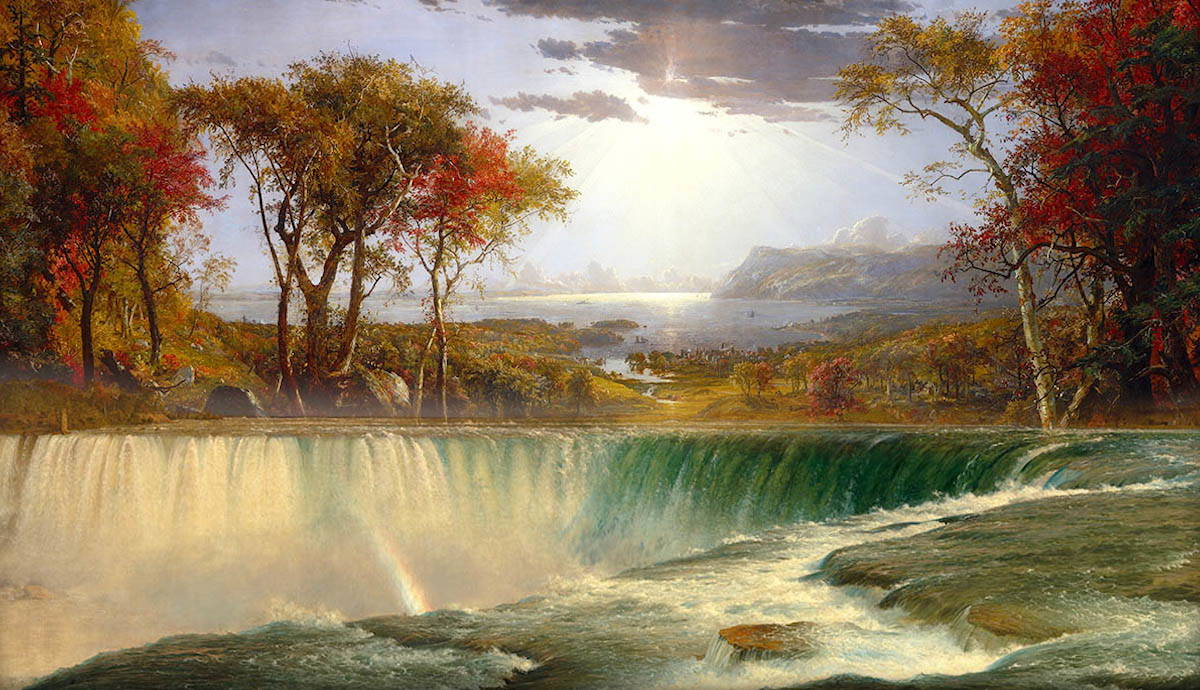
Active for nigh of the 19th century, the Hudson River School celebrated the American wilderness in landscape paintings of American fine art. This loose movement depicted ordinary rivers, mountains, and forests, too as major monuments similar Niagara Falls and Yellowstone. The associated American artists painted local scenery for its ain sake, rather than equally part of a wider narrative. This tied in perfectly with the early American idea that the nation's wilderness was as worthy of celebration every bit the very best of what Europe had to offer.
American Landscape Earlier the Hudson River School
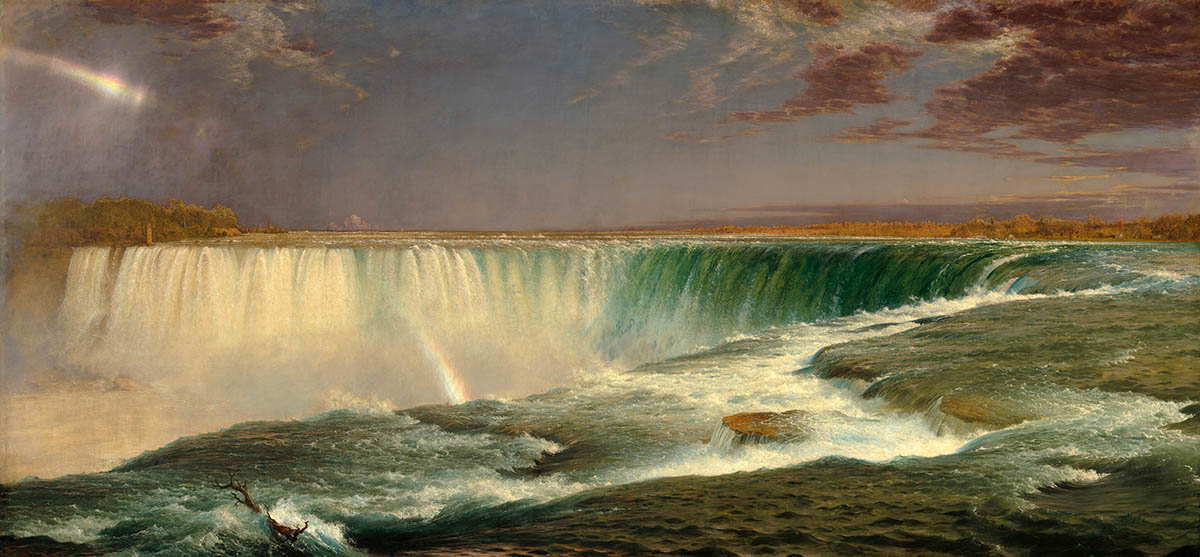
In the late 18th and much of the 19th centuries, the U.s. had a bit of an inferiority complex. Although justifiably proud of its democratic politics and hard-won independence, the new nation felt that it lagged backside Europe in terms of cultural and creative achievements. Unlike France, Italy, or England, it lacked romantic ruins, impressive monuments, literary or artistic heritage, and dramatic history. At this time, Americans had picayune interest in the long Native American history that had played out on the lands they now inhabited.
The early years of the American nation coincided with the movements of Neo-Classicism and Romanticism. 1 valued the social club, reason, and heroism of the classical past. The other prized picturesque ruins, loftier emotion, and the Sublime. Both relied heavily on the history, achievements, and concrete remnants of societies that came before them – status symbols the United States found itself lacking. In other words, America seemed like a cultural backwater to both American citizens and European observers.
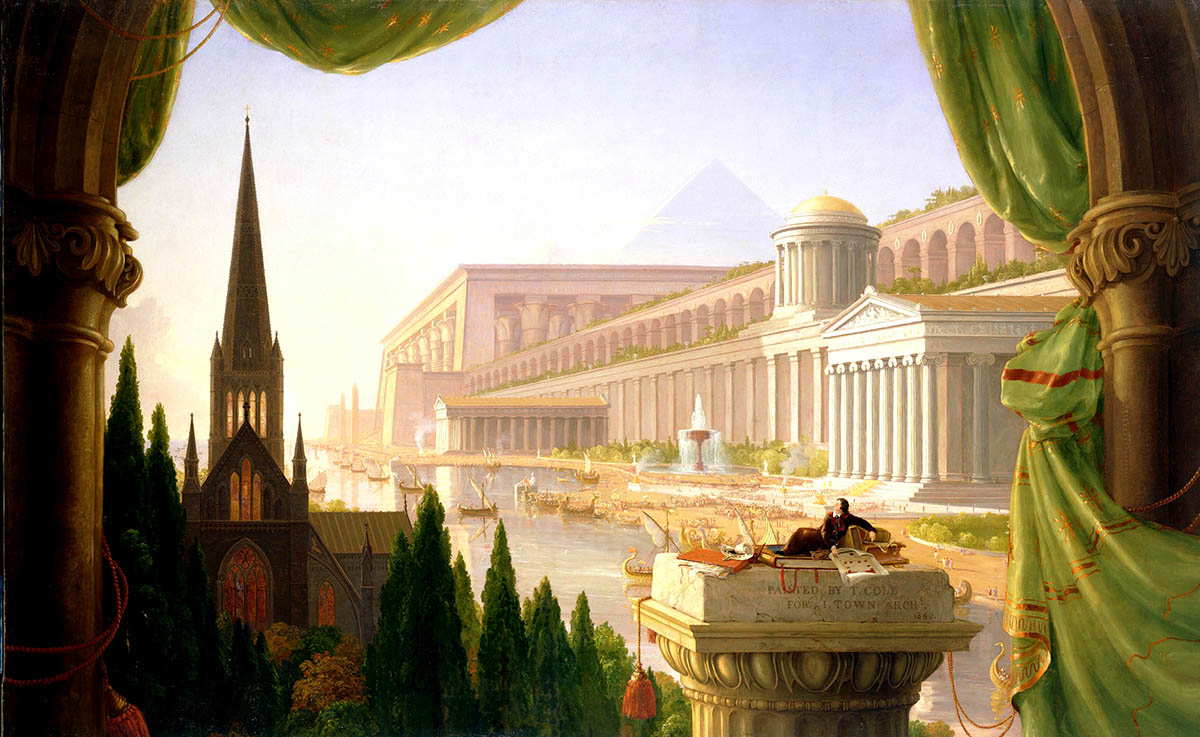
Presently, yet, thinkers such as Thomas Jefferson and Prussian naturalist Alexander von Humboldt (the original The states superfan) identified i major advantage that the Northward American continent had over Europe – the affluence of its wild and beautiful nature. In most European nations, inhabitants had been exploiting and generally altering the natural landscape for centuries. Areas of true wilderness were few and far between.
Are y'all enjoying this article?
Sign upward to our Free Weekly Newsletter
Please check your inbox to activate your subscription
Cheers!
The Americas, on the other hand, abounded in wilderness, with existing homo interventions on a much smaller calibration. The United states of america had sweeping forests, rushing rivers, clear lakes, and abundant flora and fauna, not to mention sensational natural monuments. The United States may not have the Roman colosseum, Notre-Dame de Paris, or the works of William Shakespeare, simply it did accept Natural Bridge in Virginia and Niagara Falls in New York. Here was something to celebrate and take pride in. It'southward no wonder that artists followed along, memorializing this wilderness in pigment on sail.
American Art and the Hudson River School
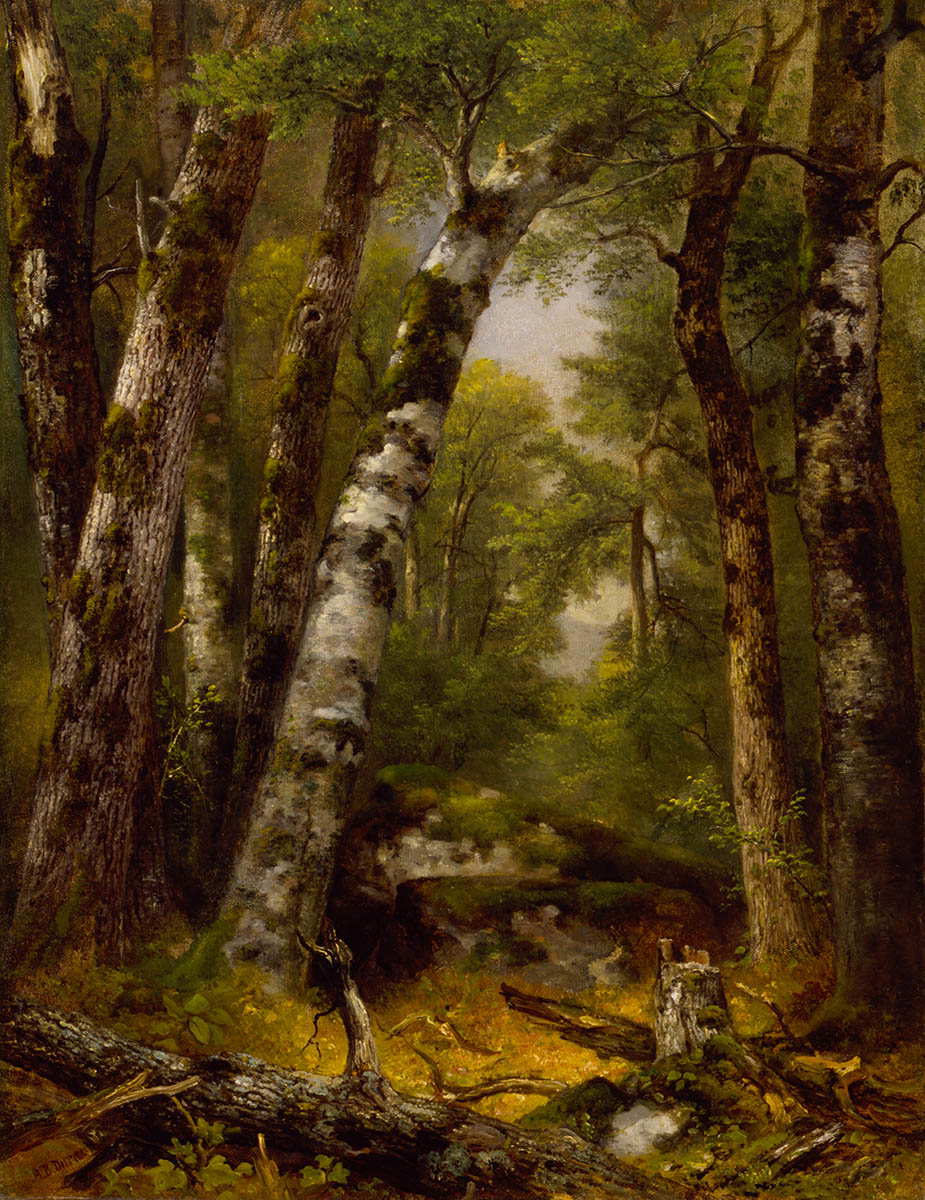
Despite its name, the Hudson River School was more of a loose movement than whatsoever sort of cohesive entity. At that place were several generations of Hudson River School painters – mainly men, both also a few women – from roughly the 1830s until the turn of the 20th century. Although earlier American painters had depicted their local surround, consensus names British-built-in painter Thomas Cole (1801-1848) the movement's true founder. Except for making landscape paintings of the American scenery, the associated artists did not share any mutual style or subject matter. Many lived and worked in the northeastern states, specifically the titular Hudson River Valley in New York. Most participants besides painted abroad.
Cole was the but Hudson River School artist to include narrative and moralizing elements in his landscape, resulting in dream-like paintings such as The Architect's Dream and The Class of the Empire series. Asher Durand painted in meticulously observed item, often filling his works with dumbo vegetation. Frederic Edwin Church, Cole's only pupil, became famous for monumental paintings of dramatic scenery that he saw on his world travels, such as Niagara and Eye of the Andes.
Jasper Cropsey's colorful renditions of the autumnal foliage, which is particularly vibrant in some areas of the United States, caught Queen Victoria's attention. A subset of painters called the Luminists was particularly focused on the effects of temper and lite, often in marine scenes. Albert Bierstadt, Thomas Moran, and others introduced easterners to the natural wonders of the American West, such as Yellowstone, Yosemite, and the K Canyon.

Hudson River School artists had a few other things in mutual, however. All were keen to discover nature, and nearly considered ordinary forests, rivers, and mountains worthy subjects for their ain sakes, rather than as vessels for a larger narrative. As such, this American art movement paralleled a contemporaneous French movement. The Barbizon School, fabricated famous past the likes of Camille Corot, besides prized en p lein air painting and rejected narratives or moral lessons as necessary in landscape paintings. However, Hudson River School paintings are rarely faithful snapshots of places as they actually appeared. In fact, many are composites of multiple related areas or vantage points.
Essay on American Scenery

In 1836, Thomas Cole wrote Essay on American Scenery, which was published in American Monthly Magazine 1 (January 1836). In it, Cole argued for the psychological and spiritual benefits of experiencing and enjoying nature. He also justified, at length, America'south pride in its landscape, detailing how specific mountains, rivers, lakes, forests, and more compared favorably to the most celebrated European counterparts. Cole'southward belief in the man benefits of enjoying nature, though blowsy in its deeply moralizing tone, still resonates strongly with 21st-century ideas about mindfulness and the value of returning to nature.
Fifty-fifty at this early on date, Cole already lamented the increasing destruction of the American wilderness in the name of progress. Yet although he chastised those who despoiled nature "with a wantonness and barbarism scarcely apparent in a civilized nation", he clearly saw it equally an unavoidable step in the nation's evolution. Nor did he become quite and then far as to put the American wilderness on par with man-fabricated European culture, as Humboldt and Jefferson did.
Rather than assertive that the majesty of the American landscape fabricated it worthy of unqualified celebration, he instead suggested that it be viewed in terms of its potential for future events and associations. Seemingly, Cole couldn't quite get past the perceived lack of (Euro-American) human history within American scenery. Other American artists, including Hudson River School painters Asher Durand and Albert Bierstadt, also wrote essays in commemoration of the native landscape and its place in American art. They weren't the only ones to choice upwards their pen to defend the American wilderness.
The Conservation Motility

One might think that citizens would accept taken great pains to preserve these wild landscapes they were then proud of. However, Americans were surprisingly quick to dismantle their natural environment in the name of agriculture, manufacture, and progress. Fifty-fifty in the early days of the Hudson River School, railroads and industrial chimneys quickly encroached on the scenery presented in paintings. Sometimes this happened when the paint was barely yet dry. The despoiling of the American landscape was a great concern for many Americans, and it quickly sparked a scientific, political, and literary motility to counteract it.
The Conservation Motility sprang up in mid-19th-century America to protect natural landscapes, monuments, and resources. Conservationists spoke out against man destruction of the natural surroundings, such equally deforestation, the pollution of rivers and lakes, and the overhunting of fish and wild animals. Their efforts helped to inspire the U.South. government to enact legislation protecting certain species and lands, especially out west. Information technology culminated in the establishment of Yellowstone as America'southward first National Park in 1872 and the creation of the National Park Service in 1916. The movement also inspired the creation of New York City's Central Park.

Prominent members of the Conservation movement included historic writers, such as William Cullen Bryant, Henry Wadsworth Longfellow, Ralph Waldo Emerson, and Henry David Thoreau. In fact, a special genre of nature essays came out of this tradition, of which Thoreau's Walden is just the most famous example. The American nature essay was related to the 19th-century popularity of travel writings, which often described the environment, and to Romanticism's celebration of nature more broadly. Hudson River School fine art fits perfectly into this milieu, regardless of whether the artists actively participated in the motility.
Information technology wasn't just artists and writers who wanted to save the American wilderness. Crucially, the Conservation Movement as well included scientists and explorers like John Muir and politicians like George Perkins Marsh. It was an 1847 speech by Marsh, a Congressman from Vermont, that gave the need for conservation its earliest expression. President Theodore Roosevelt, an avid outdoorsman, was another key supporter. We tin can think of these Conservationists as early on environmentalists, advocating for the state, plants, and animals before concerns like trash in the oceans and carbon footprints had entered the general consciousness.
American Art and the American West
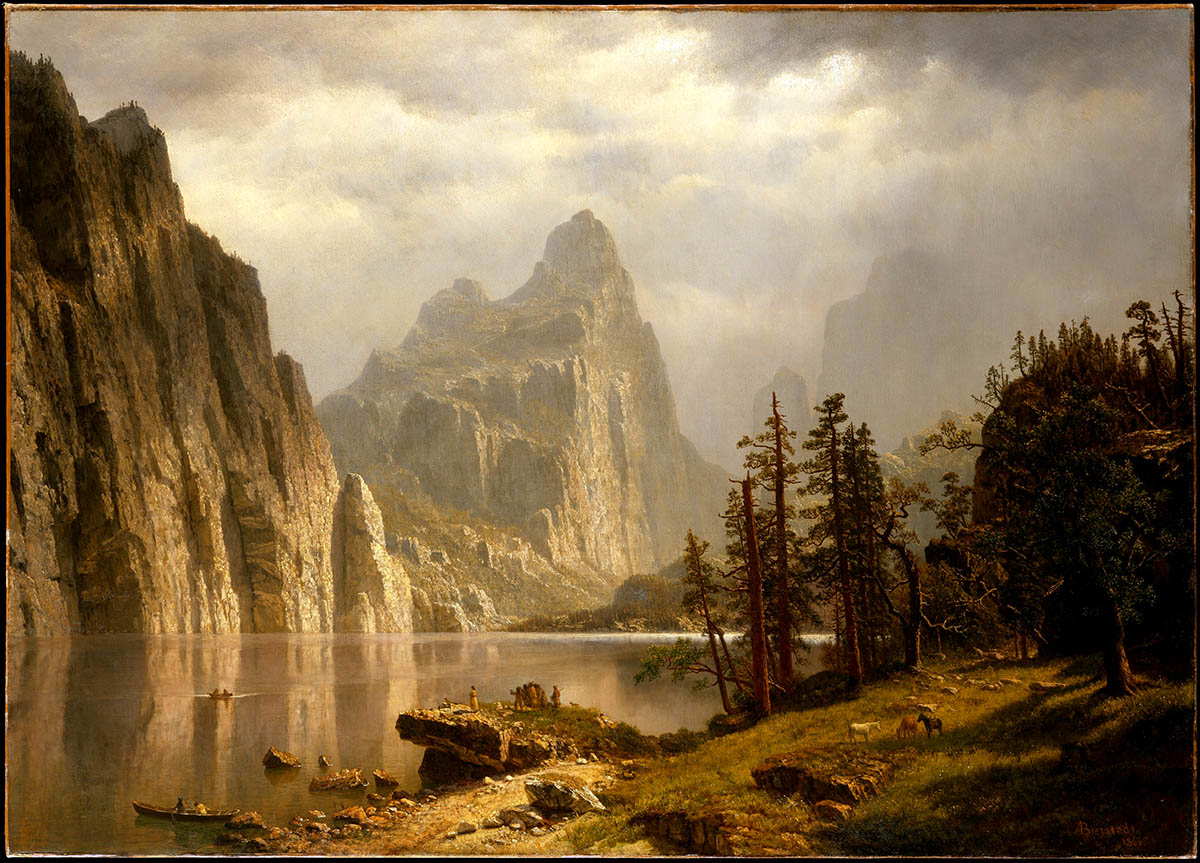
American pride in its landscape only increased as the nation pushed further west, discovering spectacular natural monuments like the Yellowstone, Yosemite, and the Grand Coulee. In the middle decades of the 19th century, the government normally sponsored expeditions to recently acquired western territories. Led by and named after explorers like Ferdinand 5. Hayden and John Wesley Powell, these voyages included botanists, geologists, surveyors, and other scientists, also as artists to document the discoveries. Both painters, notably Albert Bierstadt and Thomas Moran, and photographers, including Carleton Watkins and William Henry Jackson, participated.
Through broad reproduction in periodicals and collectible prints, their images gave countless easterners their first glimpses of the American w. In so doing, these artists helped to inspire western migration and pulsate up back up for the National Parks Organization. With their towering mountains and plunging cliff faces, these paintings really can't exist topped as examples of the Sublime landscape in American fine art.
Legacy of the Hudson River School

In their celebration of the mural in American fine art, Hudson River School artists had something in common with their 20th and 21st-century kin – contemporary artists concerned about their environment and how we treat it. Their modes have certainly changed. Naturalistic landscape painting is no longer a particularly fashionable artistic genre, and mod artists tend to be much more overt in proclaiming environmental messages. However, the Hudson River School and Conservation Movement ethics about the importance of nature couldn't possibly exist more relevant today.
Source: https://www.thecollector.com/hudson-river-school-american-art/
Enregistrer un commentaire for "Hudson River School Same Time as Other School of Art"